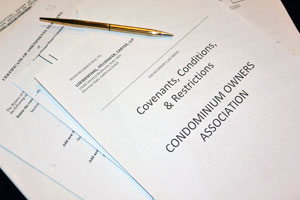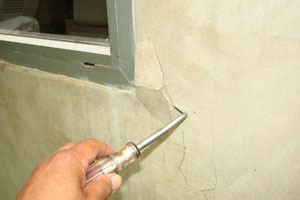The media has jumped on the topic of mold. Newspapers and magazines publish article after article about “toxic mold” and TV News Shows have featured the topic of mold. Articles addressing “toxic mold” have become commonplace in many publications and appear to have lulled many who are not immediately affected by a mold related issue into a false sense of complacency. However, mold and mold related issues are exploding across the United States and this is no time for homeowners associations to sit back and ignore the implications.
Mold has infiltrated the nation’s courthouses, both literally and figuratively, and has crept its way into the California state legislature. In one state, toxic mold verdicts in upwards of $30 million have the largest insurers in the land reeling from unfathomable, and likely inevitable, repercussions as toxic mold becomes better understood and as its harmful effects become further defined.
Certain strains of mold, such as stachybotrys, are developing evil, media friendly names like ‘black mold’, or ‘killer mold’ and are being linked to causing horrific tragedies such as infant lung hemorrhaging and mass deaths in elderly communities. Mold can destroy the building it plagues, and recent articles are even blaming toxic molds for deaths and illness of the beloved household pet.
With press like that and a future which appears to be more grim than other despised household pollutants like asbestos, lead paint, and Radon, homeowners associations have a definite interest in being prepared to deal with mold related issues and to prevent mold related issues from developing into mold related disasters.
IMPACT OF MOLD ON HOMEOWNERS ASSOCIATIONS
Some of the information available to homeowners associations regarding mold is quick to point out that developers, general contractors, and others involved in the design and construction of the buildings in the association may be found liable for mold damage after a successful construction defect suit. Available information is also quick to point out the potential liability of the association’s insurer for damages or for the mishandling of a mold related claim.
However, much of the available information ignores the result of the newfound popularity of mold litigation which has caused new mold related injuries and causes of action and in turn, new classes of popular defendants.
Homeowners associations are among those who have been silently drawn into the mix and have become prime candidates to be named as defendants in toxic mold lawsuits. Associations are considered to have potential liability because they have the ability to aggravate mold problems through the abatement procedures, or lack thereof. In addition, the homeowners association is responsible for maintaining the common areas of the association as delineated in both the Civil Code and associations’ recorded governing documents (CC&R’s). Mold growth which results from water penetration through the roofs, exterior walls or any other component maintained by the association is likely the responsibility of the association.
From the above diatribe on the horrors of any involvement with toxic mold, it should be readily apparent that becoming a defendant in a toxic mold lawsuit should be avoided and the best course of action for any association is to prevent a mold disaster before it occurs.
PREVENTING A MOLD DISASTER
Avoiding a mold disaster is an obtainable goal if the association follows some general guidelines. Awareness of the evils of mold and its potential to cripple an association if handled improperly is probably the most important step.
Evading mold problems starts with prevention. Mold is everywhere. Mold exists in the outdoor environment and as well as indoors. Mold should not generally create any problems if the mold spores outdoors and indoors are similar in both types and quantities. Non toxic mold in small quantities is inevitable in all indoor atmospheres, however, precautionary measures can be taken to prevent mold from infiltrating an association.
One of the most important preventive measures associations can take is to locate and repair all sources of water intrusion, including any defective roofing, common area plumbing leaks, exterior wall leaks, and other sources of water intrusion from common area components.
If the association stumbles at the preventive stage and a potential mold problem is discovered, there is still opportunity to avoid disaster. First, and most important, the association should contact its insurance company. The association should immediately get in touch with its insurer the first time anything resembling a mold related complaint comes from a unit owner. The insurer has a duty to deal with mold claims quickly and correctly and prompt notice will prevent the insurer from later arguing that the mold grew naturally or as a result of long time leaks and not as a result of the reported sudden water damage.
Policyholders are often discouraged from contacting their insurers. Reasons for this discouragement range from the insurers poor handling or non-responsive attitude toward a claim to a fear of non-coverage due to a so-called “mold exclusion” in the association’s insurance policy. However, policyholders should be aware that the legality of what mold losses an insurer is liable for under existing policies and the validity of the mold exclusions are yet to be determined. Similar to the rest of the ever-changing world of mold, the law in this area is equally as fluid and mold damage may be covered regardless of a mold exclusion. Insurance policies do not cover damage for slow or long term leaks. Generally, insurance policies cover sudden events such as wind driven rain pulling up roof shingles allowing water intrusion or the sudden breakage of a common area water line. Slow leaks and long term leaks are indications of deferred maintenance. Insurance policies are not meant to be “maintenance policies.”
Generally, the courts give the policyholder a helping hand when it comes to what is covered and what is not under an insurance policy. Because the court would rather find that a loss which falls into a ‘gray area’ is covered, exclusions are read with a great deal of scrutiny. Therefore, if a policy does not specifically exclude mold, then it is likely that the mold damage will be covered somewhere under one of the policy’s standard provisions dealing with water damage.
To reiterate the above, even if mold is specifically excluded by the policy, there is still a chance for coverage. Many courts are holding that ensuing loss provisions contained in policies with mold exclusions allow for coverage of mold originating from a loss which is covered under the policy. In other words, if covered water damage causes mold, then the resulting mold damage may also be covered.
New associations, or associations currently seeking to acquire insurance should be forewarned, the growing trend by the largest insurance companies is to specifically exclude coverage for all mold damage. This may effectively eliminate the ensuing loss loophole described above and would force the insured to buy additional mold coverage if it were available to homeowner associations.
Although the fate of these mold related insurance issues is yet to be determined, the rule still stands that the association should immediately contact their insurer when the possibility of a mold incident is reported. Once the insurance company is notified, it becomes time for the association to decide what should be done to eradicate their mold problem.
Regardless of the scope and degree of the problem, all allergic and toxic mold should be removed and the source of the water must be repaired. A Certified Industrial Hygienist can be hired to test both the affected surfaces as well as the air in the areas affected by the mold. The hygienist will recommend a course of action for the remediation of the mold. At that time, the association would be wise to hire a mold remediation company that has both the knowledge and equipment to properly remediate the mold. The hygienist should return after the remediation company has completed the work and do sample tests again in order to clear the area and certify The Mold and the Dutiful that the mold species and counts in the area are acceptable. The costs for mold testing by a hygienist as well as the remediation of the mold are high, however ignoring a mold problem can be much more costly.
How does an association pay for the mold testing, remediation process and repairs related to a mold problem? Usually there is no line item in an association’s budget for mold. Most associations are not funding reserves for mold. What happens to associations that are faced with an expensive mold remediation project that is not related to a construction defect claim and is not going to be covered by an insurance policy? An association could borrow from the reserves to pay for the repairs, however as per the Civil Code, the loan is to be paid back within a year. An association can raise assessments to cover the costs or possibly pass an emergency special assessment if the factual situation allows. An association can do any or all of the above if necessary to pay for the repairs. Though the costs may be high and no one likes to have to pay higher assessments, association boards of directors are charged with the responsibility to maintain the common areas in the community and must do so in order to carry out their fiduciary responsibility. Most important, a board of directors must address the mold issues that may exist in the community and take proper steps to resolve the matter. It will not help to ignore the problem if it exists, the mold menace will not just go away.
Following these guidelines should keep any association mold free, or at least provide the association with the tools to handle and prevent a mold related disaster. To recap; prevention and awareness are top priority; water intrusion is unacceptable and must be immediately remedied. If mold related damage is discovered, immediately contact the association’s insurer. If mold is present in the association, eliminate it thoroughly and immediately. Use experts when dealing with the remediation of mold. No association wants to become a defendant in a mold related property or physical injury case.


